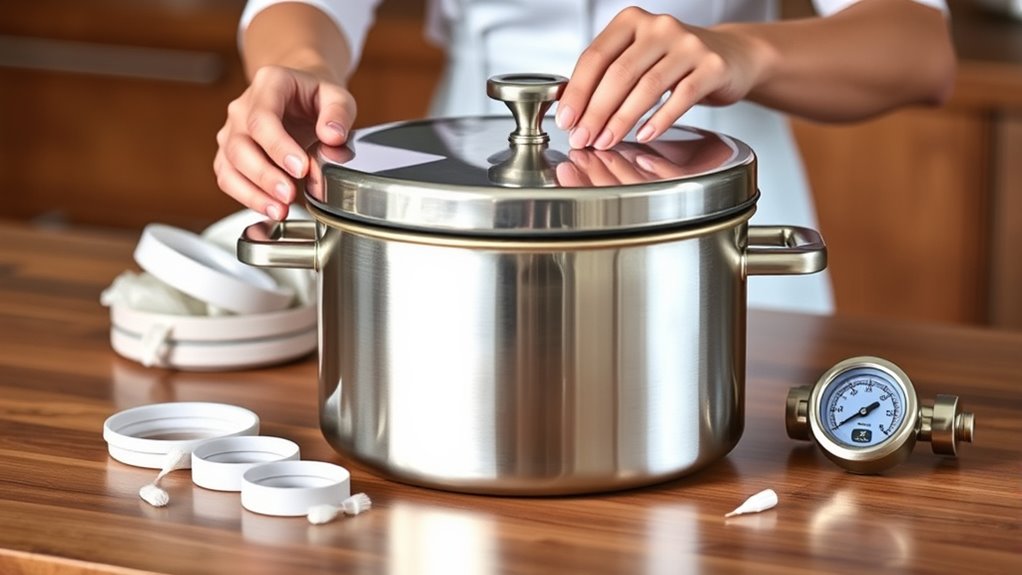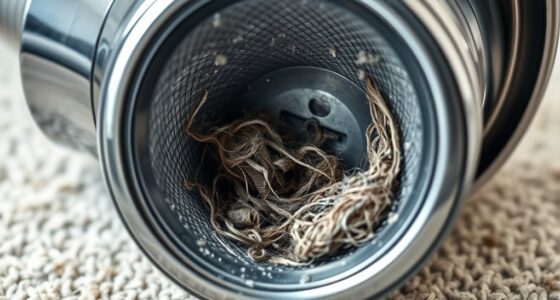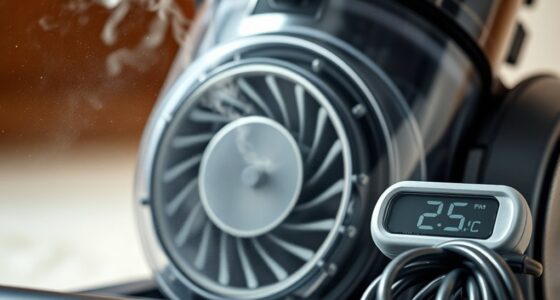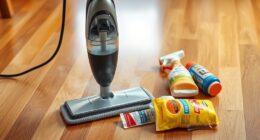To maintain perfect vacuum storage, regularly inspect your sealing equipment and replace seals or sealant before they degrade. Make certain items are thoroughly cleaned and dry before sealing, and use high-quality materials for long-lasting airtightness. Keep an eye on environmental conditions by controlling humidity and temperature, and organize your storage with clear labels. Routine checks of seals and equipment help prevent leaks and spoilage. Stay tuned for more tips on keeping your vacuum storage ideal.
Key Takeaways
- Regularly inspect and replace seals, gaskets, and sealant materials to maintain airtight conditions.
- Calibrate vacuum pumps and test equipment periodically to ensure optimal sealing performance.
- Keep storage environment cool, dry, and stable by using silica gel packs and monitoring humidity levels.
- Label and organize storage items for easy identification and to support proper rotation and maintenance.
- Conduct routine checks for leaks, seal integrity, and equipment functionality to prevent spoilage and damage.
Assessing Your Storage Needs and Setting Goals

Before you begin maintaining your vacuum storage system, it’s vital to assess your needs clearly. Determine the storage duration for your items—whether short-term or long-term—as this influences how carefully you should pack and seal them. Consider the fragility of items; delicate or easily damaged goods require extra attention to prevent breakage during storage. Think about the types of items you’ll store—clothing, documents, or perishables—and their specific needs. Setting clear goals helps you choose appropriate vacuum bags and storage conditions. Knowing your priorities guarantees you maintain an efficient, organized system that protects your items effectively. Additionally, understanding storage material durability can help you select the most suitable bags and containers for long-lasting preservation. Taking these steps upfront saves time and effort later, helping you create a storage routine tailored precisely to your needs.
Selecting the Right Vacuum Sealing Equipment and Accessories

Choosing the right vacuum sealing equipment starts with ensuring compatibility with your storage needs. Consider the sealant materials that work best and how easy they are to maintain over time. Proper calibration and regular maintenance will keep your system performing reliably and extend its lifespan. Additionally, selecting devices with high-quality components can improve durability and sealing performance.
Equipment Compatibility Tips
Selecting the right vacuum sealing equipment and accessories is vital to guaranteeing your storage setup works effectively. You need to verify that your vacuum pump is compatible with your chosen system to maintain a reliable vacuum. Sealant compatibility is also indispensable; not all sealants work with every device, so double-check that your materials match your equipment. This helps prevent leaks and maintains a perfect vacuum over time. Additionally, understanding the specific vacuum system requirements can help you choose the most suitable tools and accessories for your needs.
Here are some tips:
- Ensure your vacuum pump matches the specifications of your sealing system
- Use sealants confirmed compatible with your vacuum equipment
- Test your setup regularly to detect any sealant or equipment issues early
Sealant Material Choices
The type of sealant you use plays a key role in maintaining a reliable vacuum and ensuring your storage stays airtight. You need a sealant with the right elasticity to accommodate temperature changes and prevent leaks over time. Choose materials with favorable sealant chemical properties that resist degradation from gases or moisture, maintaining their integrity longer. Flexible sealants with high elasticity form a tighter, more durable seal, reducing the risk of air infiltration. Ensure the sealant you select is compatible with your vacuum equipment and storage environment. Properly chosen sealants will withstand repeated use and maintain their sealing capability without cracking or losing elasticity. Investing in quality materials tailored to your needs guarantees a more reliable, long-lasting vacuum storage solution. Additionally, selecting sealants with proven Glycolic Acid Benefits for Skin can enhance the overall durability and performance of your vacuum seals.
Maintenance and Calibration
Guaranteeing your vacuum sealing apparatus functions dependably begins with proper upkeep and calibration. Regularly verifying your vacuum pump calibration guarantees it produces consistent, high-quality seals, which directly influences sealant durability. Precise calibration prevents leaks and maintains ideal vacuum levels, safeguarding your stored items. When choosing equipment and accessories, emphasize those with easy-to-maintain components and straightforward calibration procedures. Additionally, selecting high-quality filter materials can enhance the overall efficiency and longevity of your vacuum system.
- Schedule routine vacuum pump calibration to sustain sealing performance
- Use high-quality sealant materials suited for your equipment
- Inspect and replace worn seals and filters promptly to avoid leaks
Properly Preparing Items Before Sealing

Before sealing your items in a vacuum storage bag, it’s essential to prepare them properly to prevent spoilage and maintain quality. Start by cleaning and drying everything thoroughly to remove dirt and moisture. Use airtight containers to store especially delicate or moisture-sensitive items beforehand, guaranteeing they stay fresh. When packing, eliminate as much air as possible and place items on moisture barriers if needed, such as silica gel packets, to absorb excess humidity. Avoid overstuffing the bags, which can prevent a proper seal. Also, make sure all surfaces are dry and free of debris. Proper preparation reduces the risk of mold, odors, and spoilage, making your vacuum storage more effective and long-lasting. Additionally, understanding proper storage techniques can further enhance your preservation efforts.
Techniques for Achieving and Maintaining a Perfect Seal
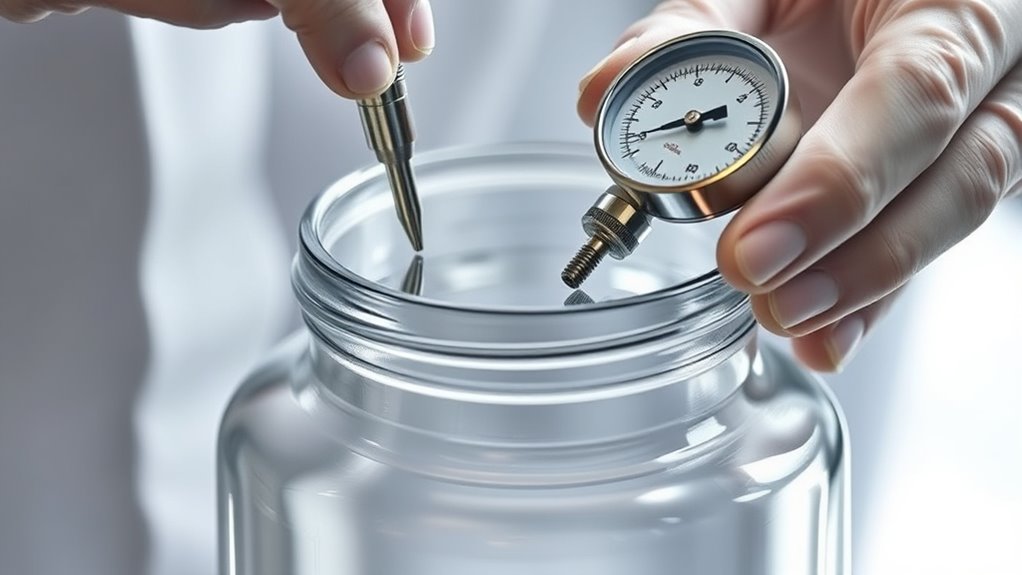
Achieving and maintaining a perfect seal requires attention to detail and proper technique. To prevent vacuum leaks and ensure seal durability, you must focus on the sealing process. First, always inspect the sealing surface for dirt or damage before sealing. Second, apply consistent pressure when sealing to avoid weak spots. Third, avoid over-tightening, which can cause stress and compromise the seal. Use high-quality vacuum sealers and check gasket conditions regularly. Proper sealing techniques help prevent vacuum leaks, maintaining the integrity of your storage. Keep the sealing surfaces clean and dry, and handle components gently to prolong seal durability. Additionally, ensure that the headphone jack is free of debris or dirt to maintain a secure connection and optimal audio performance. By paying close attention to these details, you ensure your vacuum storage remains airtight and protected over time.
Regularly Checking and Replacing Vacuum Seals
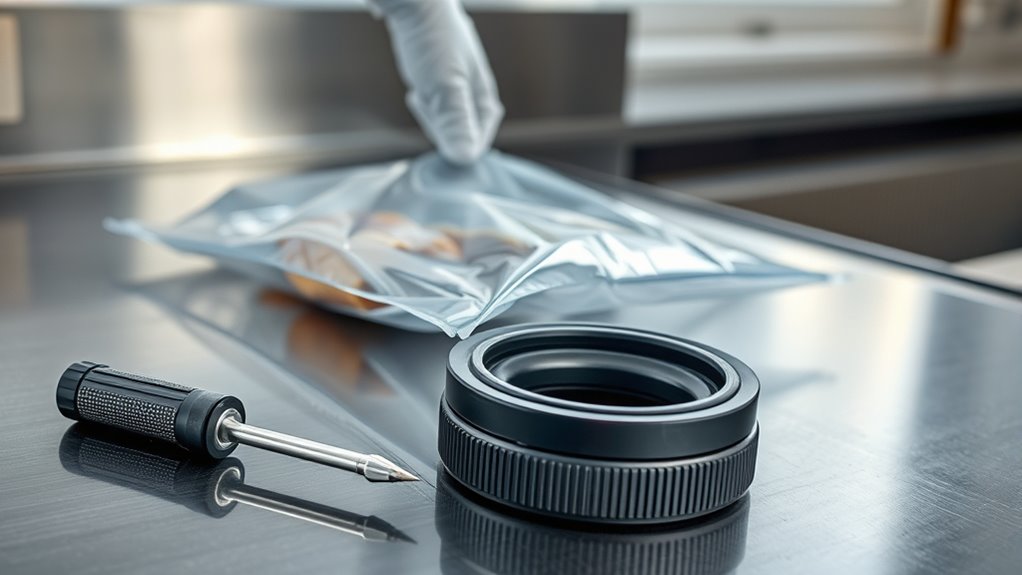
You should regularly inspect your vacuum seals for any signs of wear or damage. When you notice cracks or loss of elasticity, it’s time to replace the seals to maintain an airtight environment. Using proper re-sealing techniques guarantees your storage remains secure and effective. Additionally, ensuring the airtight seal is properly maintained can help prevent spoilage and preserve the freshness of stored items.
Seal Integrity Inspection
Regularly inspecting your vacuum seals is essential to maintaining a perfect vacuum storage environment. Over time, seals can develop small vacuum leaks or experience seal failure, compromising the storage quality. You should check for signs of air infiltration, such as cloudiness or a hissing sound. Look for cracks, tears, or deformation in the seal material, which indicate it’s no longer effective. If you notice any of these issues, it’s time to replace the faulty seal to prevent vacuum loss. Continuous monitoring of AI behavior can help identify emerging vulnerabilities in sealing techniques or materials.
Replace Worn Seals
When you notice signs of seal deterioration during inspections—such as cracks, tears, or deformation—it’s time to replace the worn seals. Worn seals compromise the vacuum, risking contamination and spoilage. Using high-quality gasket materials guarantees better sealant longevity and dependable performance. Regularly replacing damaged seals keeps your storage airtight and prevents costly failures. Incorporating proper seal maintenance practices can further extend the lifespan of your vacuum seals and ensure consistent performance.
Proper Re-sealing Technique
Maintaining an airtight vacuum storage requires diligent inspection and prompt replacement of seals whenever signs of wear appear. To guarantee vacuum seal durability and sealing process consistency, you must master proper re-sealing techniques. First, clean the sealing area thoroughly to remove debris or residues. Next, check for cracks or distortions in the seal; if any are present, replace the seal immediately. When resealing, press evenly to ensure full contact and avoid air leaks. Consistent pressure during the sealing process helps maintain the integrity of the vacuum. Regularly verify the seal after resealing by gently tugging or inspecting for leaks. Proper re-sealing keeps your storage airtight and prolongs the lifespan of your vacuum system. Additionally, understanding the importance of airtightness in your vacuum storage can further enhance the longevity of your contents.
Managing Humidity and Temperature Conditions
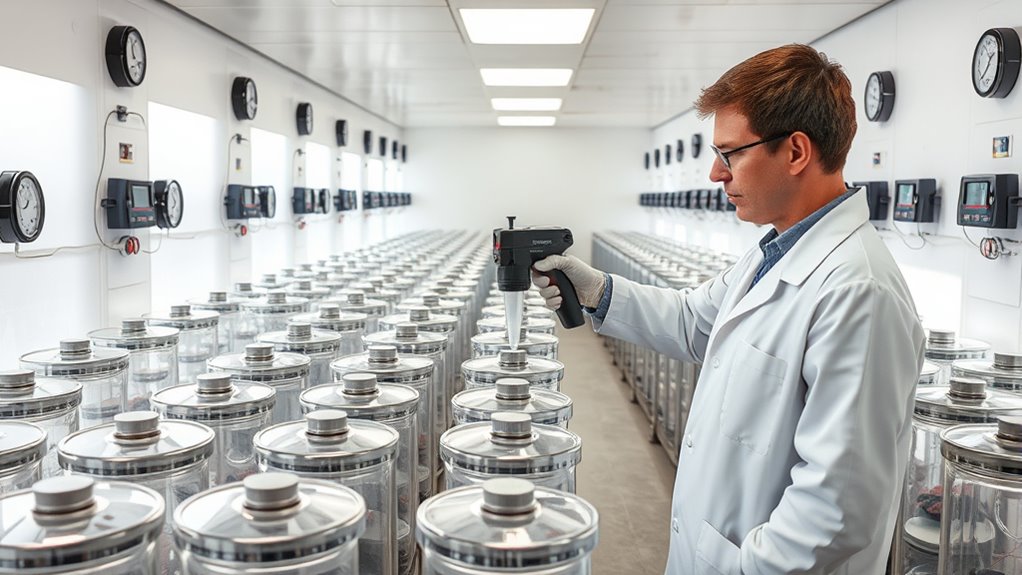
Controlling humidity and temperature within your vacuum storage is essential to preserve sensitive items effectively. Humidity control prevents mold, corrosion, and deterioration caused by excess moisture. Use silica gel packs or dehumidifiers to maintain a low humidity environment. Temperature regulation is equally important; fluctuating or high temperatures can damage delicate materials. Keep your storage in a cool, stable area away from direct sunlight, heat sources, and drafts. Regularly monitor the environment with a hygrometer and thermometer to ensure ideal conditions. Proper air quality management is crucial for preventing the buildup of moisture and pollutants that can compromise stored items. Consistent humidity control and temperature regulation help maintain the integrity of your items, preventing degradation over time. By actively managing these factors, you create a stable environment that safeguards your valuables and extends their lifespan.
Organizing and Labeling for Easy Monitoring

Organizing and labeling your vacuum storage containers makes it easier to monitor and maintain the conditions necessary for preserving your valuables. Consistent labeling ensures you can quickly identify the contents and their storage date, supporting proper storage rotation. Use clear, legible labels and stick to a uniform system to avoid confusion over time. Regularly review labels to confirm they remain accurate and visible. Proper organization helps you spot when items need to be rotated or checked, preventing spoilage or deterioration. Incorporating storage best practices can further enhance the longevity of your stored items.
Incorporating Routine Maintenance Checks and Adjustments

Regular maintenance checks are essential to guarantee your vacuum storage system remains effective over time. You should routinely inspect your vacuum pump maintenance schedule, ensuring the pump operates smoothly and efficiently. Listen for unusual noises or signs of wear, and address any issues promptly. Keep an eye on the sealant shelf life, replacing it before it degrades to prevent leaks that compromise the vacuum. Adjustments might be necessary if pressure readings fluctuate or if the vacuum loss increases. Regularly calibrate your system to maintain peak performance. Implementing necessary cookies helps ensure that your system functions correctly and securely. Consistent checks help identify potential problems early, saving you time and money. By staying on top of vacuum pump maintenance and sealant replacement, you ensure your storage remains airtight and effective, preserving your items perfectly over the long term.
Frequently Asked Questions
How Often Should Vacuum Storage Equipment Be Serviced?
You should service your vacuum storage equipment every 6 to 12 months. Regular vacuum pump maintenance is essential to keep it functioning efficiently, so check for any signs of wear or leaks. Perform seal replacement procedures as needed to maintain an airtight environment. By sticking to this schedule, you guarantee your vacuum system stays reliable, preventing contamination and preserving stored items effectively.
What Are Signs of a Compromised Vacuum Seal?
Signs of a compromised vacuum seal include visible vacuum leaks, such as foggy or cloudy storage conditions, and sudden spoilage or spoilage smells. You might notice soft or swollen packaging, indicating a loss of seal integrity. If the vacuum no longer holds, it’s a clear sign that the seal has failed. Regularly inspecting for these signs helps guarantee your storage conditions stay ideal and your vacuum remains effective.
Can Vacuum Storage Affect the Longevity of Sensitive Items?
Vacuum storage can considerably extend the longevity of sensitive items by providing airtight containers that prevent exposure to air and contaminants. Proper vacuum sealing also enhances moisture control, reducing the risk of mold or spoilage. When you maintain a consistent vacuum environment, you preserve freshness and quality longer. This method is especially effective for perishable foods, collectibles, or delicate materials, ensuring they stay in ideal condition over time.
Are There Specific Cleaning Procedures for Vacuum Sealers?
Did you know regular cleaning extends your vacuum sealer’s lifespan by up to 30%? For vacuum sealer maintenance, clean the seals and edges with a damp cloth after each use to prevent residue buildup. Use sealing technique tips like avoiding overfilling and ensuring the bag’s edge is flat before sealing. This keeps your sealer working efficiently, reduces leaks, and preserves your stored items longer.
What Tools Are Recommended for Troubleshooting Seal Failures?
For troubleshooting seal failures, you should use a leak detection solution or soapy water to identify leaks. A small, pointed tool like a seam roller or plastic spatula helps with seal repair by pressing and resealing edges. Additionally, a flashlight aids in visual inspection of the seal for cracks or debris. These tools make leak detection and seal repair easier, ensuring your vacuum sealer maintains a perfect seal.
Conclusion
By tending to your vacuum storage with gentle care and attention, you create a cozy, secure environment where your items can rest undisturbed. Regularly inspecting and fine-tuning your setup is like tending a delicate garden—ensuring everything stays healthy and vibrant. With patience and a keen eye, you’ll foster a storage space that whispers of reliability and peace, allowing your treasured belongings to flourish quietly, preserved in their perfect, silent sanctuary.
